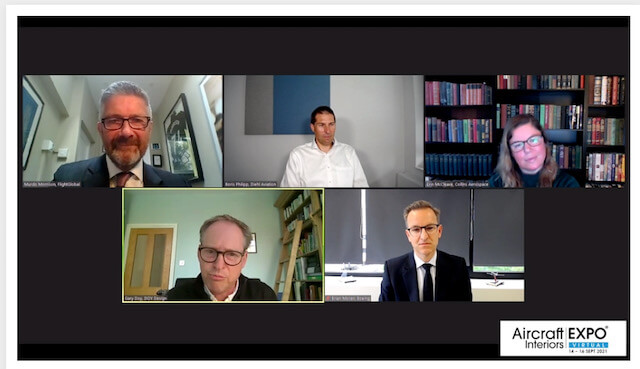AIX Virtual: Tackling sustainability challenges requires industry-wide collaboration

Top left to right row: Murdo Morrison of Flightglobal; Dr. Jan-Boris Philipp of Diehl Aviation; and Erin McCleave of Collins Aerospace
Bottom: Gary Day of DOY Design (left); and Brian Moran of Boeing
A tightly competitive industry is sharing a common challenge as it emerges from the pandemic to face a world that is demanding sustainable practices and development of new products to operate greener.
Tackling the sustainability challenge will come through development of new materials, products with longer lifespans and addressing the ever-present need to reduce weight in the aircraft. Those solutions and more were part of a panel discussion on the carbon footprint of the aircraft cabin at the Aircraft Interiors Expo (AIX) Virtual entitled, 'Reducing the cabin's environmental footprint.'
Moderating the hour-long session was Murdo Morrison, Head of Strategic Content at Flightglobal. Speakers were Dr. Jan-Boris Philipp, Head of Research Systems at Diehl Aviation; Gary Doy, Managing director of DOY Design; Brian Moran Vice President, Global Sustainability Policy and Partnerships at Boeing; and Erin McCleave, Executive Director, International and Aftermarket Strategy at Collins Aerospace.
How to achieve the goals of making a more sustainable aircraft will require a collaborative effort that is already taking place, said McCleave. Recently, she said she has seen an optimistic “call to action” to address the environmental challenges from all corners of the industry.
“What we see as a result of that call to action across every stakeholder group is a wonderful uniformity of purpose. I know in my years in the industry I can't think of another time when you see such energy around collaboration and willingness to set aside the traditional dynamics and models,” she said.
One area where consensus was really present in the discussion was the on the subject of weight reduction. Moran pointed to the efforts by Boeing with its ecoDemonstrator aircraft that is designed to bring new technologies and materials into the cabin. The company recently tested an inner sidewall from made from recycled carbon fiber on the 777X production operations.
Philipp said Diehl has been studying ways to cut weight through the potable water on board the aircraft. For example, Diehl sees possibilities with the use of “gray water” on board the cabin, particularly in the lavatories. There, Diehl has studied the possible reuse of water that passengers use for handwashing transferred to the additional use of flushing toilets. Diehl calculated that such practice could save up to 250 kilograms of weight to the cabin of a 787.
Much of the savings in weight, cost and environmental impact can be addressed in the design process says Doy. While there is attention to sustainability when products are developed, he says there is also a revenue stream that comes from parts replacement through the life of the products, which creates waste.
“Creating the things that potentially break quicker, and we get to change them and because that is part of the business plan the business model we’re forced into that situation. And I think we need to step back a little bit from that,” Doy said.
Before the pandemic, legacy airlines were in competition to develop luxurious cabins to lure premium and business travelers. When those passengers come back, will there be the same front cabin features and perks waiting for them? Panelists in the session seemed to agree that passengers in the front cabin are going have different priorities. Comfort will be required, but safety and hygiene will be a large part of the equation as well.
McCleave said the need to make passengers feel safe is going to be a long-term trend. Not only that, personal feelings about the sustainability of air travel are beginning to influence consumer choices.
The need for people to feel connected to family and friends is not going to go away, she said, “also maybe (passengers need to) feel that choice is aligned with their sustainability objectives personally so that they can feel good about it.”
Doy added that he sees in the near future airlines taking a much more aggressive approach to branding and promoting their sustainability practices.
Boeing is currently working with Adient the automotive seat maker on lightweight seating products in the cabin. Collins Aerospace recently introduced its Lilacs-UV lighting developed by Boeing which sanitizes the cabin.
“I would worry about the day we as a sector stop innovating,” Moran said. “Think about what happens every time a new generation of products is introduced. There is new capability introduced.”
In the next 10 years, each of the panelists had goals and visions. McCleave repeated her optimism at the collaboration of the industry around sustainable practices and technologies. Philipp said goals will be accomplished through big and small steps in parallel. Alternative fuels need to be evaluated in the same as changes in cabin materials. Doy said the industry needs to be more “disruptive” and challenge product development and communicate with customers. Moran said Boeing’s priorities are safety and sustainability in tandem as the company competes for the 19,000 new aircraft in that will be needed in the next decade.

